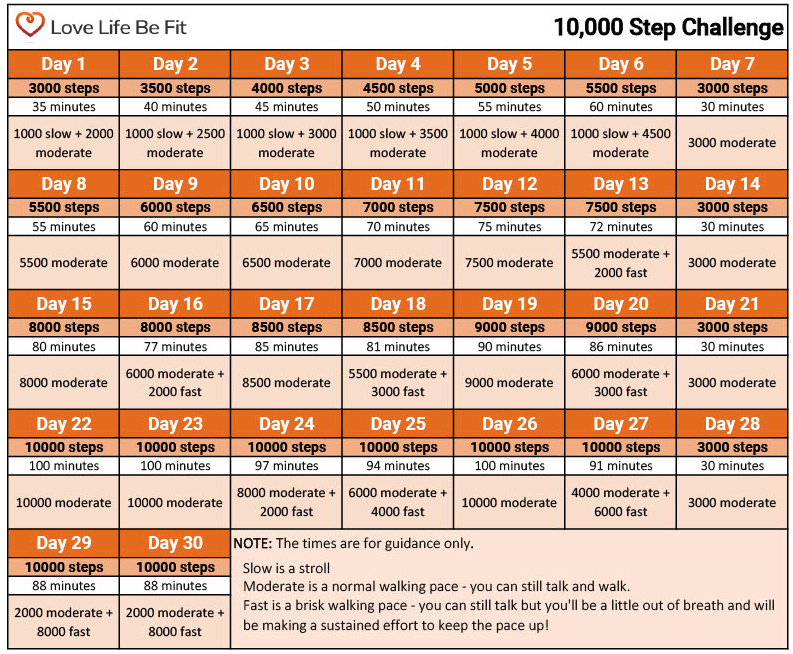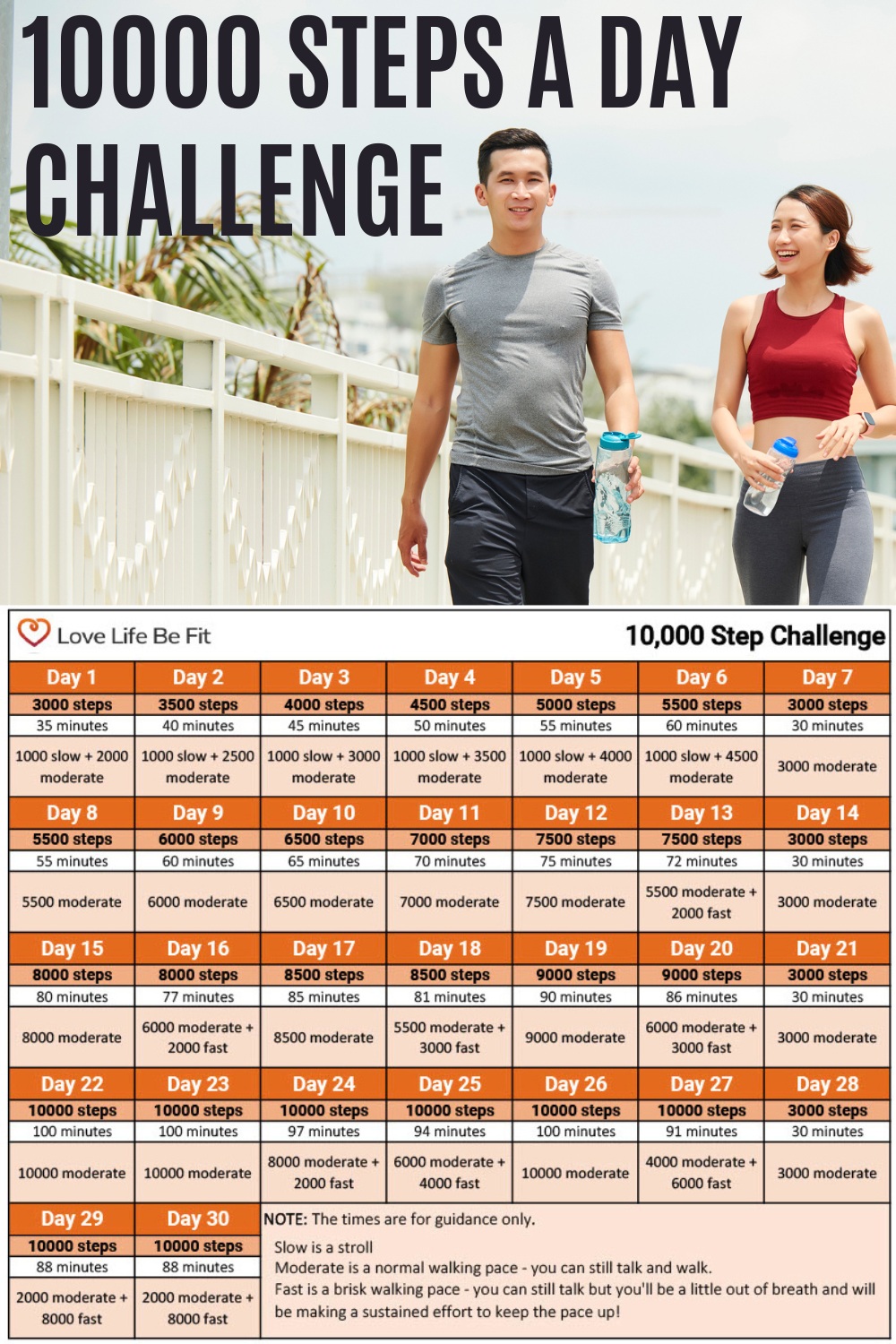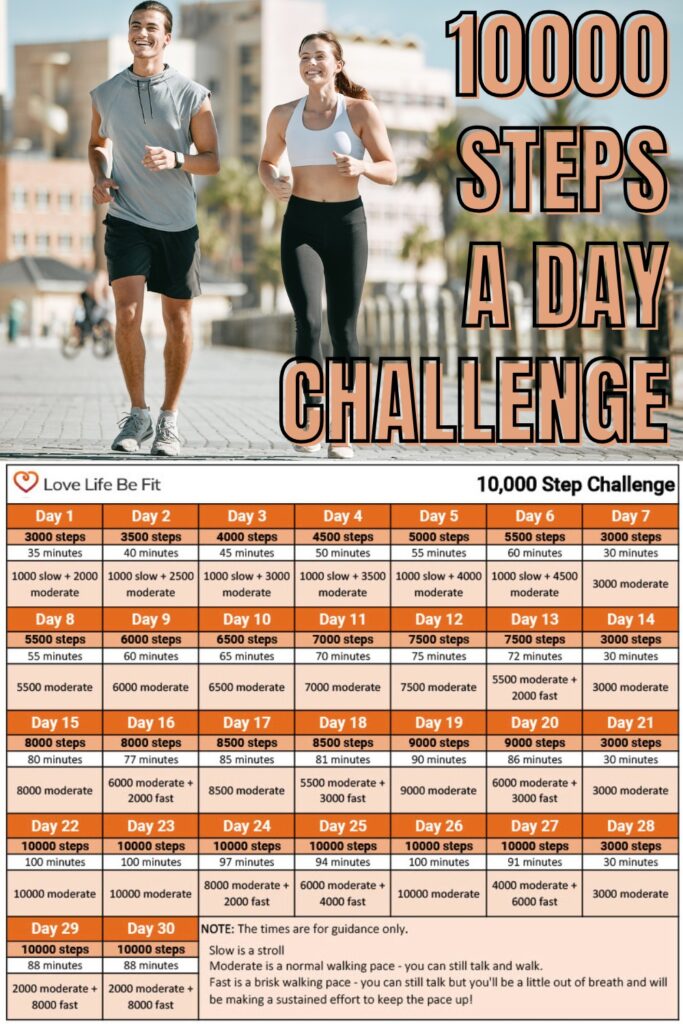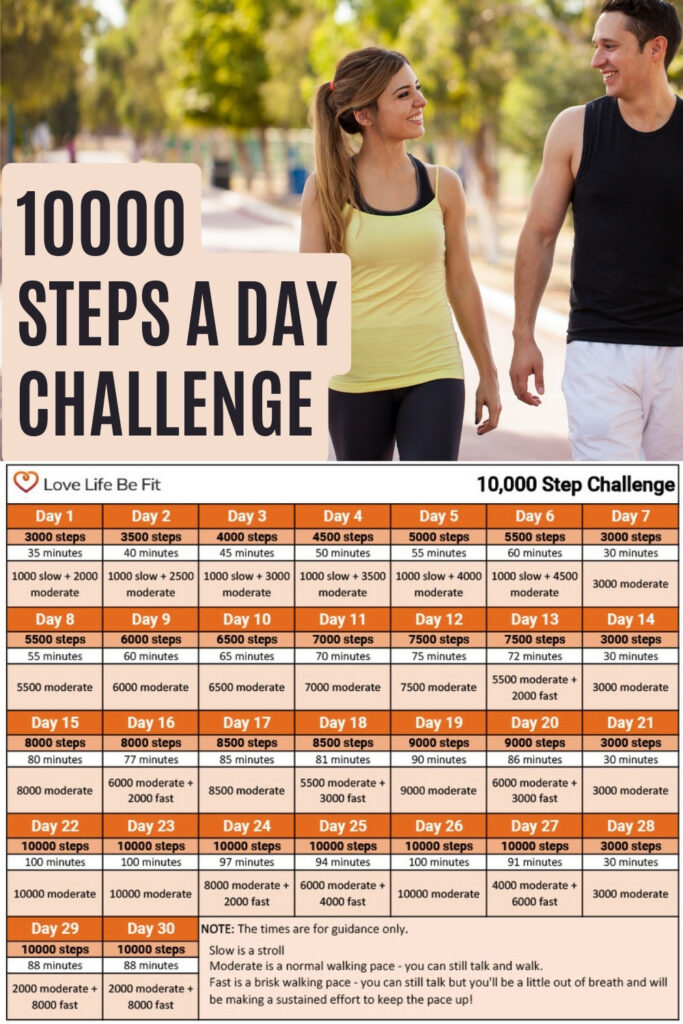10000 Steps A Day Challenge: How To Start, Tips And Benefits
The 10000 steps challenge is a simple idea and can be very effective. Walk 10,000 steps a day and benefit from the extra physical activity. Most people will feel fitter and lose some weight with a daily walk. It can be a great way to get in shape.
So how do you reach this step goal? This walking plan will help you build up your daily step total gradually until you’re walking 10,000 steps a day with ease. All you need is an activity tracker – a fitness app or pedometer to count your steps, a comfortable pair of walking shoes or trainers – and maybe a water bottle.

The 10,000 Steps Challenge
The 10,000 steps challenge has its roots in Japan. It was first introduced to encourage people to be more active and participate in regular exercise in the run-up to the 1964 Tokyo Olympics.
The fitness drive coincided with the launch of a new device – a pedometer with a default setting of 10,000 steps as a daily step goal. Possibly this is where the concept of 10,000 steps a day comes from.
Manpo-Kei, the Japanese term for 10,000 steps meter became a rallying cry and gradually spread around the world as more and more people took up the challenge.
10,000 isn’t a magic number of steps – but 10,000 steps in distance is about 4-5 miles. It’s a significant amount of physical activity and enough to have a big impact on your health.
A study: America On The Move, conducted in 2003 concluded that most Americans don’t walk enough with adult Americans walking an average of 5117 steps a day. The figure is just as low for most developed countries. I suspect for the average person with a desk job that figure will be a lot lower.
So if you’re ready for a new challenge, let’s try and add more steps to your daily routine!
Related post: How Many Miles In 10000 Steps (And How Many Calories Burned)

How To Get To 10,000 Steps A Day
Using a fitness tracker or steps app can help you monitor your physical activity and make sure you’re hitting your step target.
Building up to 10,000 steps a day is all about taking it slow and steady. Wear a tracker for a few days and get an idea of your normal daily step count.
Start by setting yourself an achievable goal such as walking an extra 1000 steps a day above your base level. Gradually increase your target each week. Follow these tips to get more steps in a day!
You can also break down your 10,000 step goal into smaller chunks such as 2,500 or 3,000 steps at a time.
Make sure to listen to your body and take regular breaks to make sure you’re not overdoing it – after all, it’s better to go slow than to burn out.
If you wake up stiff and tired it’s okay to take a rest day but you’ll probably find going for a shorter easy walk will help you recover.
Following my 10,000 steps program below will help you hit your target in no time!
Related post: How To Start A Walking Program For Beginners

How long does it take to walk 10,000 steps?
The time it takes to walk 10,000 steps depends on your walking pace.
It takes between 70 to 80 minutes to walk 10,000 daily steps at a brisk pace of 3.5 miles/hr.
For a slower pace of 3.0 miles/hr, allow 90 to 100 minutes.
These paces are faster than the typical pace people walk when they’re going about their daily activities. Most people walk at around 2.4 miles/hour – so to hit these times you need to put some effort into your walking.
Related post: How Many Steps In A Mile Walking Or Running?
The 30 Day 10,000 Steps A Day Challenge
Take the 10000 step challenge! Use this plan to gradually increase your daily step target and add more steps to your daily routine.
Before you start, spend a few days checking your current daily step total. Once you know how many steps you already take a day – jump into the plan at that level.
If you find a week too much of a challenge – it’s okay to repeat a week.
The walking challenge uses different speeds:
- Slow is a stroll – use this pace to warm up.
- Moderate is a normal walking pace – you can still talk and walk.
- Fast is a brisk walking pace – you can still talk but you’ll be a little out of breath and will be making a sustained effort to keep the pace up!
You don’t need to walk all your steps in one go. You can split them into two or three blocks – just make sure you prioritize walks in your daily schedule!

Benefits Of Walking 10,000 Steps Every Day
If you currently have a sedentary lifestyle, increasing physical activity levels can make a big difference to your overall health. Here are some of the health benefits of walking:
Lower risk of chronic diseases
Regular walking can lower the risk of stroke, cardiovascular diseases, and diabetes.
Stronger bones and muscles
Regular physical activity such as walking improves strength and balance and can increase bone density which helps to reduce the risk of osteoporosis.
Mental health
Fresh air and exercise help to reduce stress, improve moods and help to manage symptoms of depression.
Weight loss & weight management
Increasing your daily activity can help with weight loss – for a healthy weight combine walking with making small positive changes to your diet. Moving more is a good start but good health is about more than just exercise. Try and eat better with a diet rich in vegetables, fruit, and healthy whole grains.
Walking is an excellent form of exercise for avoiding weight gain – a lot of people find it’s a good way to keep the pounds off for good!
These are just some reasons for following the step challenge. Walking with friends and exploring nature are great ways to enjoy a healthy lifestyle – and at the same time increase your daily activity.
Related post: Walking 5 Miles A Day: Benefits And What Happens To Your Body?

How Many Steps Per Day To Lose Weight?
Most people burn around 80 calories per mile walking at a brisk pace – that’s 320 to 376 for 10,000 steps.
That’s a potential weight loss of 3 pounds in 30 days.
Doesn’t seem very much? Well, think of it this way – that could be permanent weight loss every month.
In reality, it’s really difficult to estimate your weight loss from walking. If you have a lot of weight to lose and you haven’t exercised for a while – taking the challenge will be a big effort. You can expect to notice a big difference in your health almost from the word go.
But weight loss will depend just as much on what you eat. It’s not enough just to be active. Make sure you don’t replace calories lost from walking with eating extra food – combine exercise with a healthy diet to get the best results.
If you’re already reasonably fit – walking may not be enough of a challenge. Make it harder by walking up hills, walking intervals, or running for weight loss.
Related post: Why You’re Not Losing Weight Walking

Tips And Avoiding Pitfalls
These tips will help you make progress and avoid some of the biggest pitfalls:
#1 Avoid too much walking
It’s easy to get carried away with a challenge and do too much too soon. But just remember – the last thing you want is to end up injured. If you’re getting stiff or sore – take a rest day.
#2 It isn’t all about the highest number on your step tracker
Quality is more important than quantity with the step challenge. Desperately walking on the spot late at night to hit your step target isn’t the answer to getting fit. Plan your schedule to fit in some quality exercise sessions.
#3 Find creative ways to walk more
Taking the dog for a walk, walking to meet friends, taking the stairs instead of the lift – these are all good ways to walk more. Get creative to fit walks into your routine.
#4 Take a short walk
You don’t need to walk all 10,000 steps in one go! Split up your steps into 2 or 3 short walks. Walk in the morning before work, take a quick lunchtime walk around the nearby park, and add a mile or two in the evening.
#5 Advice if you’re on your feet all day
Not everyone has a sedentary job and it often doesn’t make sense that people who are on their feet all day can still be overweight. Does it mean walking for weight loss doesn’t work?
Not at all. If you’re on your feet all day, for example as a teacher or nurse or working in a store, you’re getting a low level of exercise. Your step count might be high but it’s not always the right exercise – probably slow steps and if you’re in a busy job – high-stress levels that contribute to weight gain.
Instead of just aiming for a step target, try adding some short quality walks to your day – times when you can de-stress, enjoy some fresh air and walk at a brisker pace. This will help you sleep and make healthier food choices.

A Word From Life Life Be Fit
Getting fit is a journey. You won’t get everything right straight away. Instead, listen to your body, record your progress, and act on what’s working.
At the end of the challenge period – keep going! You can keep to 10,000 steps a day or mix things up with intervals, hill climbs, or cross-training. Or even take on a walking 20000 steps a day challenge!
You’ve got this!








